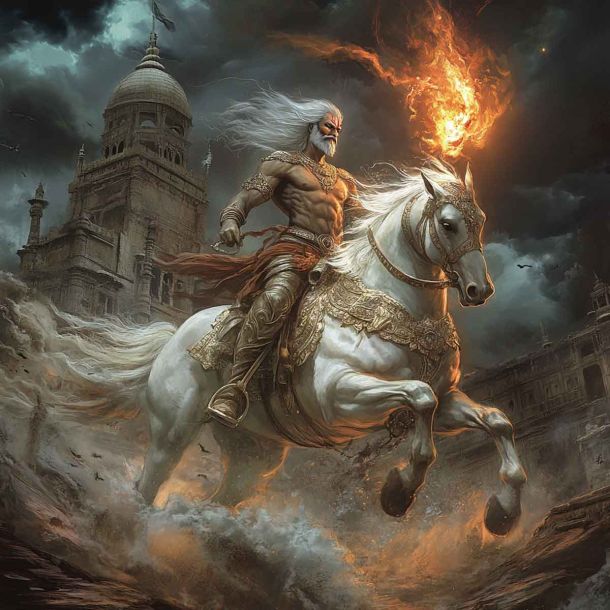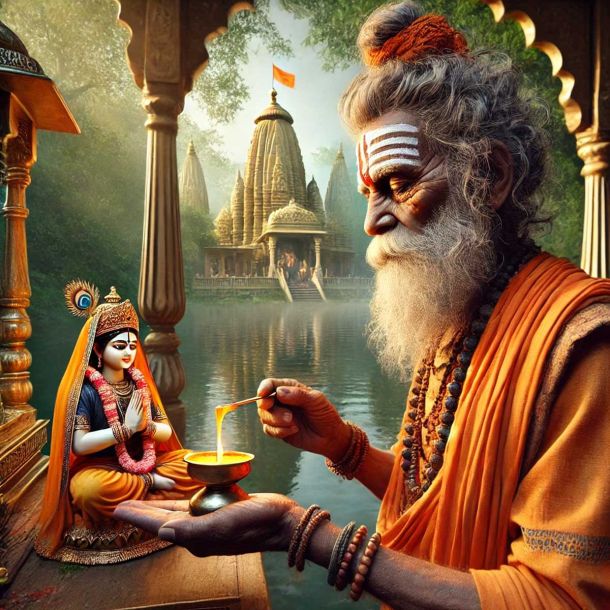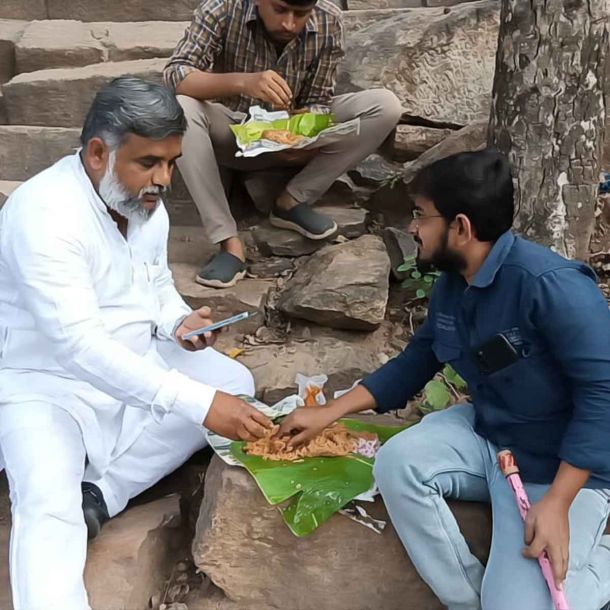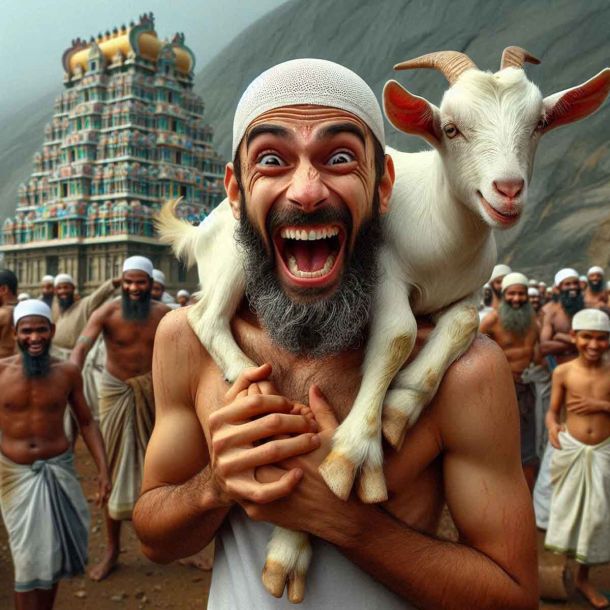More Coverage
Twitter Coverage
Satyaagrah
Written on
Satyaagrah
Written on
Satyaagrah
Written on
Satyaagrah
Written on
Satyaagrah
Written on
Join Satyaagrah Social Media
"Who is Hindu": In real sense, grand tradition can be defined and understood as ten thousand faiths gathered in harmony under a single umbrella is Hinduism, Sanatan Dharma, where dharma is the duty, and karma is our actual behaviour

Hinduism is a diverse tradition and very different from other monolithic religions. In the monolithic sense, it is defined by The Four Pillars. Faith (sraddha) is individualistic whereas religion (dharma) is collective, and so Hindus are encouraged to explore their faith, which is why there are more Hindu scriptures and textual opinions on spirituality than any other religion. There isn’t a single scriptural or spiritual authority to define matters of the faith for Hindus, unlike in some other religions with a central pontiff.
There are several different denominations, the four largest being Vaishnava, Saiva, Shakta, and Smartha. Further, there are numberless schools of thought, or sampradayas, expressed in tens of thousands of guru lineages, or paramparas. Each is typically independent and self-contained in its authority. In a very real sense, this grand tradition can be defined and understood as ten thousand faiths gathered in harmony under a single umbrella called Hinduism, Sanatan Dharma. The tendency to overlook this diversity is the common first step to a faulty perception of this religion. Most spiritual traditions are simpler, more unified, and unambiguous. In the definitive sense a Hindu or Sanatan is any person who believes that by abiding by the Law of Karma and Five Precepts and practicing Karma, Bhakti, or Gyana yogas the soul can attain Moksha or spiritual progress. And a Hindu is one of the members of the Ārya Samudāy.
All too often, despite its antiquity, it's profound systems of thought, the beauty of its art and architecture, and the grace of its people, Hinduism remains a mystery. Twisted stereotypes abound that would relegate this richly complex, sophisticated, and spiritually rewarding tradition to little more than crude caricatures of snake-charmers, cow-worshipers, and yogis lying on beds of nails.
Fortunately, there is an easier, more natural way to approach the vastness of Hinduism. From the countless living gurus, teachers, and pundits who offer clear guidance, most seekers choose a preceptor, study his teachings, embrace the sampradaya he propounds, and adopt the precepts and disciplines of his tradition. That is how faith is followed in actual practice. Holy men and women, counted in the hundreds of thousands, are the ministers, the defenders of the faith, and the inspirers of the faithful.
Four Basic Principles
At this supremely dangerous moment in human history, the only way of salvation is the ancient Hindu way." - Mark Twain
One way to gain a simple (though admittedly simplistic) overview is to understand the four essential beliefs shared by the vast majority of Hindus:
- Doctrine of Moksha (salvation),
- Law of Karma (what salvation is based on),
- Five Precepts (how to stay in accord with the law), and
- Three Yogas (support of the precepts.)
It could be said that living by these four principles (tattvas) or pillars is what makes a person a Hindu.
Moksha
Moksha is a Sanskrit word meaning:
- to liberate
- to free from
- to get rid of
It means freedom from worldly bondages which only lead to rebirths such as love, anger, greed, delusion, lust, and envy. The Upanishads state that man suffers from three types of Taapa. Moksha is the only way to get rid of these three miseries.
Moksha is the state of absolute bliss wherein we realize that the perceiver, the perceived, and the object of perception are all one and the same.
Moksha is the breakage of the cycle - the cycle of mind, the cycle of time, the cycle of births, i.e., transcending existence.
Moksha is referred to by many names. For example, it is also addressed as mukti or freedom, and other terms for this state are apavarga, kaivalya, kalyana, nihsreyasa, nirvana, sayujya, and yoga-ksemma. A pursuer of Moksha is a Moksha-kami[1] or Mumuksha.
- Reincarnation: Punarjanma, is the natural process of birth, death, and rebirth. At death, we drop off the physical body and continue evolving in the inner worlds in our subtle bodies, until we again enter into birth. Through the ages, reincarnation has been the great consoling element within Hinduism, eliminating the fear of death. We are not the body in which we live but the immortal soul which inhabits many bodies in its evolutionary journey through samsara. After death, we continue to exist in unseen worlds, enjoying or suffering the harvest of earthly deeds until it comes time for yet another physical birth. The actions set in motion in previous lives form the tendencies and conditions of the present life and the next. Reincarnation ceases when karma is resolved, God is realized and moksha, liberation, is attained. The Vedas state, “After death, the soul goes to the next world, bearing in mind the subtle impressions of its deeds, and after reaping their harvest returns again to this world of action. Thus, he who has desires continues subject to rebirth”[1].
- All-Pervasive Divinity: As a family of faiths, Hinduism upholds a wide array of perspectives on the Divine, yet all worship the one, all-pervasive Supreme Being hailed in the Upanishads. As Absolute Reality, God is unmanifest, unchanging, and transcendent, the Self God is timeless, formless, and spaceless. As Pure Consciousness, God is the manifest primal substance, pure love, and light flowing through all forms, existing everywhere in time and space as infinite intelligence and power. As Primal Soul, God is our personal Lord, the source of all three worlds, our Father-Mother God who protects, nurtures, and guides us. We beseech God’s grace in our lives while also knowing that He/She is the essence of our soul, the life of our life. Each denomination also venerates its own pantheon of Divinities, Mahadevas, or “great angels,” known as Gods, who were created by the Supreme Lord and who serve and adore Him. The Vedas proclaim, “He is the God of forms infinite in whose glory all things are — smaller than the smallest atom, and yet the Creator of all, ever living in the mystery of His creation. In the vision of this God of love, there is everlasting peace. He is the Lord of all who, hidden in the heart of things, watches over the world of time”[2].
 |
Karma
Karma literally means “deed” or “act” and more broadly names the universal principle of cause and effect, action and reaction which governs all life. Karma is a natural law of the mind, just as gravity is a law of matter. Karma is not fate, for man acts with free will, creating his own destiny. The Vedas tell us if we sow goodness, we will reap goodness; if we sow evil, we will reap evil. Karma refers to the totality of our actions and their concomitant reactions in this and previous lives, all of which determine our future. It is the interplay between our experience and how we respond to it that makes karma devastating or helpfully invigorating. The conquest of karma lies in intelligent action and dispassionate reaction. Not all karmas rebound immediately. Some accumulate and return unexpectedly in this or other births. The Vedas explain, “According as one acts, so does he become. One becomes virtuous by virtuous action, bad by bad action”[3].
Karma is a fundamental concept that has no direct translation into English. It has multiple levels of applicability and can approximately be defined as the natural order of action and each action has an associated result often called the fruit of the karma. The three karmas are Sanchita, Prarabdha, and Agami, and the 3 afflictions are Adhyatmika, Adhidaivika, and Adhibhautika.
"Though Karma is shaped by desires, it does not cease to exist when desires vanish." - Sriranga
As you sow, so you reap is the gist of the theory. Each action has fruit and it depends on many factors:
- Sincerity in action
- The purpose of action
- The means chosen
- Righteousness of action[1]
One reaps the fruit of one's actions. Apart from the direct result of action or its effect on the surroundings, each action creates an impression on its doer. These impressions accumulate and constitute the karma of the individual. Any action done in the present is aided and affected by the impressions of previous actions. Thus Dharma forms the basis for Karma and many principles are consequent of the Karma theory, like:
- Don't hurt anyone.
- Do unto others only what you want to be done unto yourself.
- Do those actions that bring happiness to oneself and do good to others.
- Do not speak harshly.
- Wish only good for others.
- Do not hesitate to take up cudgels to protect dharma.
When men are thus good and cooperative with each other, social well-being is caused. If for some reason it is disturbed, it would be restored sooner or later, either because men realize the order going bad or because nature intervenes to restore the order. For self-realization (Mokṣa), one has to work on the self to rid of bad karma. Self-conforming is expounded by philosophers throughout the ages:
"For one who has conquered the mind, the mind is the best of friends. But for one who has failed to do so, his very mind will be his greatest enemy" — Krishna
"Conquer callous, cruel, and insensitive feelings toward all beings" — Patanjali
"Some think themselves the conqueror of the ten directions, yet have not even conquered the six enemies within, which are their own five senses and mind" — Narada[2]
"To conquer oneself is a greater victory than to conquer thousands in a battle" — Gautama Buddha
"Fight with yourself. Why fight with external foes. He who conquers himself will obtain happiness" — Vardhamana Mahavira
"By conquering oneself, one conquers the world" — Guru Nanak
Five Precepts
The principles of Sanatana Dharma were made to create and maintain the proper working of a society and its members and governors. Regardless of the circumstances, the principles and philosophy of Hinduism remain the same: the ultimate aim of human life is to realize its true form.
- God Exists. According to the Hindu religion, there is only one Absolute Divine, a singular force that joins all facets of existence together known as the Absolute OM (sometimes spelled AUM). This divine is the Lord of All Creation and a universal sound that is heard within every living human being. There are several divine manifestations of the OM, including Brahma, Vishnu, and Maheshwara (Shiva)
- All Human Beings Are Divine. Ethical and moral behavior is considered the most prized pursuit of human life. The soul of an individual (jivatma) is already part of the divine soul (the Paramatma) although it remains in a dormant and deluded condition. It is the sacred mission of all humans to awaken their souls and make them realize their true divine nature.
- Unity of Existence. The seekers aim to be at-oneness with God, not as separate individuals (oneness of self), but rather with a closer connection (at-one-ness) with God.
- Religious Harmony. The most basic natural law is to remain in harmony with its fellow creatures and the universal.
- Knowledge of 3 Gs. The three Gs are the Ganges (the sacred river in India where the cleansing of sins occurs), the Gita (the sacred script of the Bhagavad-Gita), and the Gayatri (a revered, sacred mantra found in the Rig Veda, and also a poem/intonement in the same specific meter).
Three Yogas
The triple Yoga of service, devotion, and knowledge are essential for self-realization. One does not contradict the other. Together, they help the growth and harmonious development of the heart, mind, and intellect. It is mere folly to discard any of these in the course of one's onward march towards the goal of life. Each Yoga supplement helps and complements the others.
The Bhagavad Gita says:
Sankhya yogau prithak Balah pravadanti na pandithaah (Children, not the wise, say Yoga and knowledge are distinct)
Though Sri Sankara was a pure Advaita Vedantin he always worshiped a personal God. He composed many verses and hymns in praise of Devi, Lord Krishna, Hari, Siva, and others. He did Lokasangraha or selfless service unto humanity. There was no power on earth to compel him to do work. He was free as a bird. Yet he served untiringly. He established four Mutts. He initiated deserving students into Sannyas. He hoisted the flag of Vedanta and established its supremacy over other philosophers. He put down the misleading heads of various cults and schools who led humanity astray. He put them on the right path. His philosophy today stands unparalleled. He wrote several inspiring and elevating books. He inspires us even today through his many commentaries, such as Prasthanatrayi.
In one of his hymns to Hari, Sri Sankara says, "O Lord, though I and you are one, yet I am thine but mine, just as the waves belong to the ocean only, and not the ocean to the waves".
Swami Madhusudan Saraswati, one of the reputed saints of the 8th century A.D was a Poorna Gnani and a Bhakta. Even after he realized the all-pervasive Self or Brahman he worshiped Lord Krishna. He said, "Though I behold the one Atman in all beings and see all as one yet my taste or craving for the worship of the feet of Krishna never leaves me. To me, Krishna is the highest reality."
Krishnat-param kimapi tattavam aham nahjane (I do not know of any superior reality than Krishna)
Though sant Tukaram was a great Bhakta, he had the cosmic and Supreme Advaitic Realization. A Bhakta attains the state attained by Gyanins as observed from the lives of the South Indian Saiva saints like Tirumala Nayanar, Appar, Sundaramurthi, etc. Though they adored Lord Siva with all their heart they had the highest realization of Brahman.
The practice of Karma Yoga and Bhakti Yoga is as difficult as that of Gyana Yoga. Keeping up with Atma Bhav while practicing Karma Yoga in the world is more difficult than the practice of Jyana Yoga while remaining in the cave.
Work must be done for the divine alone and in union with the divine and with the right spirit and attitude. By doing constant selfless service with Ishwararpan Buddhi the aspirant develops Bhakti. His will gets merged into the Divine Will. His ego slowly perishes. Action done with the right spirit and mental attitude is as powerful and effective as devotion and meditation. Action, devotion, and knowledge go together. Internal development and perfection are possible only through the practice of this triple Yoga (Yogatraya). Karma Yoga includes meditation and devotion. Lord Krishna says to Arjuna, " Remember me at all times and fight" i.e., do your duty." Take refuge in Me and surrender the fruits of all your actions unto Me." "Smarana" of the Lord consecrating the fruits of all actions and self-surrender (Atma Nivedan) which are the fundamental doctrine of Karma Yoga are really devotion in essence. Incessant untiring selfless work leads you from devotion to knowledge and fulfills the purpose of life.
Dharma
When God created the universe, He endowed it with order, with the laws to govern creation. Dharma is God’s divine law prevailing on every level of existence, from the sustaining cosmic order to religious and moral laws which bind us in harmony with that order. In relation to the soul, dharma is the mode of conduct most conducive to spiritual advancement, the right, and righteous path. It is piety and ethical practice, duty, and obligation. When we follow dharma, we are in conformity with the Truth that inheres and instructs the universe, and we naturally abide in closeness to God. Adharma is in opposition to divine law. Dharma is to the individual what its normal development is to seed—the orderly fulfillment of an inherent nature and destiny. The Tirukural reminds us, “Dharma yields Heaven’s honor and Earth’s wealth. What is there then that is more fruitful for a man? There is nothing more rewarding than dharma, nor anything more ruinous than its neglect.”[4]
Dharma is the foundation of the whole universe. In this world, people go unto a person who is best versed in dharma for guidance. By means of dharma, one drives away evil. Upon dharma, everything is founded. Therefore, dharma is called the highest good. — Taittiriya Aranyaka
Rta
Rta is the universal norm identified with the truth which, when brought to the level of humanity, became known as dharma, the righteous order here on Earth — Taittiriya Aranyaka
Put simply rta is the [divine] order, dharma is the duty, and karma is our actual behaviour.
References:
 Support Us
Support Us
Satyagraha was born from the heart of our land, with an undying aim to unveil the true essence of Bharat. It seeks to illuminate the hidden tales of our valiant freedom fighters and the rich chronicles that haven't yet sung their complete melody in the mainstream.
While platforms like NDTV and 'The Wire' effortlessly garner funds under the banner of safeguarding democracy, we at Satyagraha walk a different path. Our strength and resonance come from you. In this journey to weave a stronger Bharat, every little contribution amplifies our voice. Let's come together, contribute as you can, and champion the true spirit of our nation.
 |  |  |
| ICICI Bank of Satyaagrah | Razorpay Bank of Satyaagrah | PayPal Bank of Satyaagrah - For International Payments |
If all above doesn't work, then try the LINK below:
Please share the article on other platforms
DISCLAIMER: The author is solely responsible for the views expressed in this article. The author carries the responsibility for citing and/or licensing of images utilized within the text. The website also frequently uses non-commercial images for representational purposes only in line with the article. We are not responsible for the authenticity of such images. If some images have a copyright issue, we request the person/entity to contact us at satyaagrahindia@gmail.com and we will take the necessary actions to resolve the issue.
Related Articles
- Construction of Ram Mandir in Ayodhya is in full flow with the foundation work finished, main contractor for construction is Larsen & Toubro while Tata Consulting Engineers are project management consultant
- "Words on a page can hypnotize you if the rhythm is right": “Kalinga narthana” literally means “Kalinga dance” in Sanskrit, referring to a legend in which Shri Krishna, as a young boy, danced on the serpent Kaliya to stop him from poisoning Yamuna river
- "Where snakes are family, fear sheds its skin": Maharashtra, in Shetpal village cobras roam freely amongst residents, a unique testament to India's deep-rooted harmony with nature, challenging perceptions and captivating visitors with its serpentine charm
- Maa Annapurna returns to India after 107 years of exile in Canada: Murti will be installed at Kashi Vishwanath Mandir in Varanasi
- "People without knowledge of their past history, origin & culture is like a tree without roots": Assamese Bhaona - traditional art with religious messages of truthfullness & dharma, created by 6th century saint-reformer Mahapurush Srimanta Sankardeva
- The Spiritual Centre of Hindu Society - Defence of Hindu Society
- Rana Sanga, the symbol of bravery who defeated Sultan Ibrahim Lodhi and fought Muslim Terrorists for Hindu Existence
- "Crumbling Chronicles, their stories yearn to be retold": Each intricately carved stone horse in the Pir Panjals carries a profound secret. Once symbols of Bharat's grandeur, now overshadowed by indifference, and their plea for acknowledgment grows louder
- Idols of Hindu deities, including Hanuman and Ganesha found lying in the debris in Gujarat’s Vadodara, Mayor Keyur Rokadia performs pooja, assures to re-establish them
- RTI reply revealed that keys to the treasure room 'Ratna Bhandar' of Puri Jagannath temple which has a lot of gold, silver, and precious jewels donated by devotees and kings over the centuries have been ‘missing’ since 1970: Odisha
- "Untold Love Story": Queen Rudabai tricked Mahmud Begada by agreeing to marriage only after the completion of the Adalaj Stepwell, a cherished project started by her late husband, King Veer Singh, and then sacrificed her life to protect its sanctity
- Indonesia: Sukmawati Sukarnoputri, daughter of Indonesia's first president becomes a Hindu leaving Islam
- Jhalkaribai: The Indian Rebellion Of 1857 Who Took on British Forces Disguised as Laxmibai
- Distinguished Hindu statesman Rajan Zed read invocations in 109 legislative bodies of Utah, containing Sanskrit hymns from the world’s oldest extant scripture: bestowed with the World Interfaith Leader Award
- Bhagwad Gita course for corporates is all set to launch at IIM Ahmedabad, will teach management and leadership
























